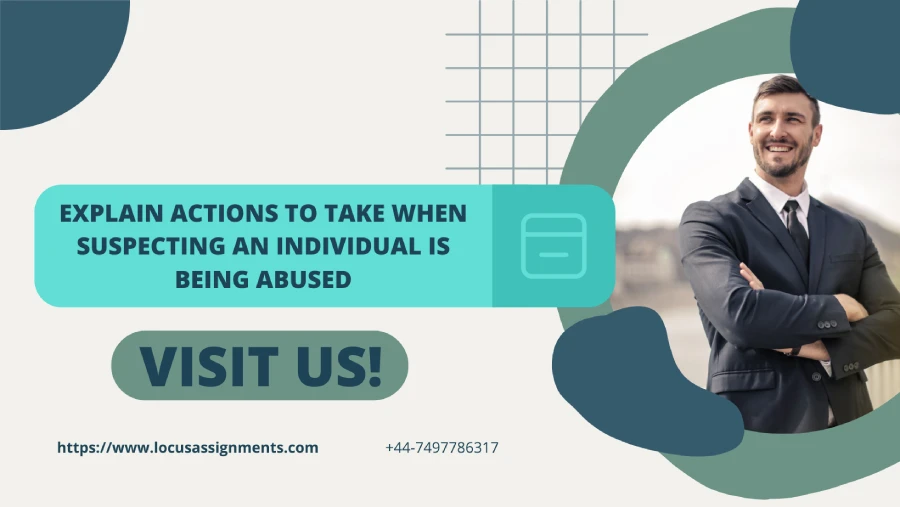Explain actions to take when suspecting an individual is being abused

2.2 Explain actions to take if there are suspicions that an individual is being abused
Course: NVQ Level 4 Diploma In Health And Social Care (RQF)
Unit 12: Understand safeguarding and protection in health and social care settings
LO2: Understand how to respond to suspected or alleged abuse
When there is reasonable cause to suspect abuse of a person, it is important to act professionally and sensitively. Responding in an appropriately structured, sensitive, and legally responsible way can help secure and protect the vulnerable person.
1. Stay Calm and Rational
When you suspect abuse, it is important to remain calm and not jump to conclusions, nor make accusations without evidence. Remaining rational and poised ensures that your decisions are driven by fact and not by emotion.
2. Watch and Record Your Observations
Watch for acknowledgement of changes in the behaviour, appearance and condition, and record these observations. Recording observations should be factual and include details such as dates, times, what you observed, and general statements. Proper documentation is important to put support actions in place down the track.
3. Take Action to Ensure Immediate and Future Safety
If a person is in immediate danger or will require immediate medical assistance, you need to contact emergency services. If there is no immediate risk, take the required steps to make sure their safety is secured within the sector (e.g., ensure they are in a separate space away from a suspected practitioner but in a safe area).
Numerous health and social care students in the United Kingdom find it challenging to write structured safeguarding reports as one of their requirements. If you want help, Locus Assignments - a leading assignment helper UK - can help you know how to prepare professionally written and evidenced based documentation for your academic assessments.
4. Avoid Direct Confrontation with the Suspected Abuser
Do not approach the suspected abuser and "confront" them, as this could escalate the situation or put the person who may have been abused at risk. Always follow the sector's safeguarding procedures.
5. Adhere to Organisational Safeguarding Procedures
Promptly report your concerns to the Designated Safeguarding Lead (DSL) or senior safeguarding officer in your organisation. They will lead on any further steps and liaise with external agencies if necessary.
6. Provide Full Information in Reporting
When making a report, please include your recorded notes, any direct disclosures, and any pertinent background information. As far as possible, it is important to only share information with individuals who need to know to maintain confidentiality.
7. Respond Supportively if Abuse is Disclosed
If the person shares information regarding abuse with you:
Listen to what has been said, without judgement.
Reassure the person that they did the correct thing in coming forward.
Do not ask leading questions or ask for more information than is necessary.
Let the person know that you cannot assure confidentiality, as information may have to be passed on for their safety.
8. Seek Consent Where Possible
In all circumstances, seek consent for which information can be shared. However, if the person is at risk of harm, safeguarding procedures allow you to share information without consent to safeguard the person.
9. Keep the Individual Informed
Where appropriate, explain what is going to happen next and involve them in decisions about their protection and care.
10. Continue Monitoring and Supporting
After your initial report, monitor the person's wellbeing and make sure the agreed safeguarding is respected. Provide emotional and practical support where appropriate and feasible.
Summary
The key steps are: be calm, take written records of evidence, safeguard the person first, do not confront the perpetrator, phone safeguarding right away, maintain confidentiality, support the victim sensitively, seek to gain their consent, keep them informed, and provide follow-up to the safeguarding report.
Need Assignment help?
Get the expert assignment helper in UK!
Fast • Reliable • Expert Support
Upload NowOther Assignments